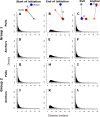Compromise or choose: shared movement decisions in wild vulturine guineafowl
- PMID: 38218910
- PMCID: PMC10787764
- DOI: 10.1038/s42003-024-05782-w
Compromise or choose: shared movement decisions in wild vulturine guineafowl
Abstract
Shared-decision making is beneficial for the maintenance of group-living. However, little is known about whether consensus decision-making follows similar processes across different species. Addressing this question requires robust quantification of how individuals move relative to each other. Here we use high-resolution GPS-tracking of two vulturine guineafowl (Acryllium vulturinum) groups to test the predictions from a classic theoretical model of collective motion. We show that, in both groups, all individuals can successfully initiate directional movements, although males are more likely to be followed than females. When multiple group members initiate simultaneously, follower decisions depend on directional agreement, with followers compromising directions if the difference between them is small or choosing the majority direction if the difference is large. By aligning with model predictions and replicating the findings of a previous field study on olive baboons (Papio anubis), our results suggest that a common process governs collective decision-making in moving animal groups.
© 2024. The Author(s).
Conflict of interest statement
The authors declare no competing interests.
Figures






Similar articles
-
GROUP DECISIONS. Shared decision-making drives collective movement in wild baboons.Science. 2015 Jun 19;348(6241):1358-61. doi: 10.1126/science.aaa5099. Science. 2015. PMID: 26089514 Free PMC article.
-
Moving as a group imposes constraints on the energetic efficiency of movement.Proc Biol Sci. 2025 Feb;292(2041):20242760. doi: 10.1098/rspb.2024.2760. Epub 2025 Feb 19. Proc Biol Sci. 2025. PMID: 39968615 Free PMC article.
-
Efficient movement strategies mitigate the energetic cost of dispersal.Ecol Lett. 2021 Jul;24(7):1432-1442. doi: 10.1111/ele.13763. Epub 2021 May 11. Ecol Lett. 2021. PMID: 33977638
-
Understanding how animal groups achieve coordinated movement.J Exp Biol. 2016 Oct 1;219(Pt 19):2971-2983. doi: 10.1242/jeb.129411. J Exp Biol. 2016. PMID: 27707862 Free PMC article. Review.
-
Decision-making processes: the case of collective movements.Behav Processes. 2010 Jul;84(3):635-47. doi: 10.1016/j.beproc.2010.04.009. Epub 2010 May 8. Behav Processes. 2010. PMID: 20435103 Review.
Cited by
-
Multi-level societies: different tasks at different social levels.Philos Trans R Soc Lond B Biol Sci. 2025 Mar 20;380(1922):20230274. doi: 10.1098/rstb.2023.0274. Epub 2025 Mar 20. Philos Trans R Soc Lond B Biol Sci. 2025. PMID: 40109119 Free PMC article.
-
Shared leadership beneath the waves.Nat Ecol Evol. 2024 Nov;8(11):2010-2012. doi: 10.1038/s41559-024-02534-1. Nat Ecol Evol. 2024. PMID: 39313584 No abstract available.
-
How Can Overlooking Social Interactions, Space Familiarity or Other "Invisible Landscapes" Shaping Animal Movement Bias Habitat Selection Estimations and Species Distribution Predictions?Ecol Evol. 2025 Jan 8;15(1):e70782. doi: 10.1002/ece3.70782. eCollection 2025 Jan. Ecol Evol. 2025. PMID: 39781261 Free PMC article.
References
-
- Galton F. Vox populi (The wisdom of crowds) Nature. 1907;75:450–451. doi: 10.1038/075450a0. - DOI
Publication types
MeSH terms
Grants and funding
LinkOut - more resources
Full Text Sources

